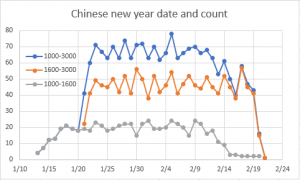Lunar cycle: 29.53 days, 12 cycles: 354.36 days; solar year: 365.24 days, the gap is 10.88 days; after around every 3 years, a leap lunar month is inserted to adjust the gap; more accurately every 19 years, 7 leap months needed. A general way to calculate the next new year day is to extract 10 or 11 days from last year’s and after 2 consecutive years then add 18 or 19 days. The strange thing is year 1582 and 1583 have the same new year day.
Since AD 1000, the earliest new year arrives on 1/13, happened 4 times: 1017, 1469, 1507, 1545; the latest 2/21, only once before AD 3000, year 2319. From 1000 to 1600, the averaged new year day is earlier than that from 1600 to 3000. The averaged new year date is 2/3 but between 2/4-2/5 since AD 1600 and 1/30-1/31 before AD 1600. Mostly the new year is between 1/21 and 2/19.
As 19 years is a perfect round, the same new year day occurs every 19 years. Because there are 30 new year date candidates (from 1/21 to 2/19), actually what is reappearing is the 30/19 day period. Therefore, as an example, new year date 2/5 after 19 years could become 2/4. From 1600 to 3000, each 30/19 day period occurs 74 times and the 30 new year dates occur 47 times in average.

